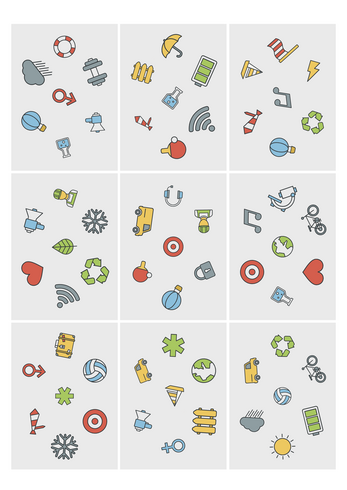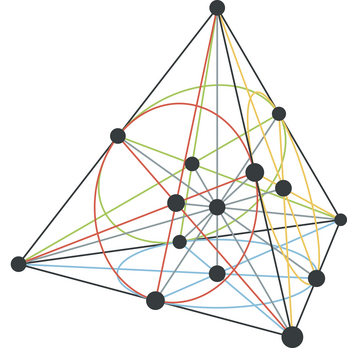
Pivot Pawns
A downloadable game
Pivot Pawns is a find-the-match puzzle game for any number of players. Pivot Pawns can be played in 15-30 minutes and is intended for players who are at least eight years old.
Components
- 15 cards (pivot_pawns_cards.pdf)
- Each card displays seven different icons, a centre icon and six other icons.
- Each icon is displayed on three different cards.
- For every pair of cards, there is exactly one icon that is displayed on both cards.
- There are a total of thirty-five different icons.
- Each icon is rendered in one of five colours: red, green, blue, yellow, or black.
- 15 target tokens (pivot_pawns_tokens.pdf)
- Each target token displays one icon.
- 5 pawns
- There is one pawn in each of the icon colours.
- 5 placeholder tokens
- There is one placeholder token in each of the icon colours.
- 1 sand timer (approximately thirty seconds)
- 1 cloth bag
Set Up
- Shuffle the cards.
- Deal the cards face up on the table in a tableau consisting of three rows and five columns.
- Put the sand timer beside the tableau.
- Put the target tokens into the cloth bag.
- Place each pawn on one of the five starting cards.
- The centre icons of the starting cards are the following: music notes, flask, Mars symbol, leaf, and sun.
- Place each pawn on a card which has a centre icon of a different colour to that pawn.
- Do not place more than one pawn on any card.
- Place each placeholder token on the card where you placed the pawn of the same colour.
Playing the Game
The game takes place over a series of fifteen rounds.
During each round, your objective is to collect the target token for that round. To do so, you must move the active pawn onto the target card. The active pawn is the pawn that matches the colour of the icon displayed on the target token. The target card is the card that displays the icon on the target token in its centre.
The game ends after you have played fifteen rounds. Whoever has collected the most target tokens at the end of the game wins.
Moving the Pawns
During the game, you will move the pawns around the tableau. When a pawn is placed onto a card, that card is occupied by that pawn.
In most cases, you may not move a pawn onto a card on which has a centre icon of the same colour as that pawn.
Crucially, however, you may move any pawn onto the target card during a given round. In fact, in order to collect the target token in each round, you must move the pawn that matches the colour of the centre icon of the target card onto that card.
To move a pawn, you perform an action called a pivot by doing the following:
- Identify the moving pawn. The moving pawn is the pawn that you will move with this pivot.
- Identify the pivot pawn. The pivot pawn will determine how you can move the moving pawn.
- Identify the pivot icon. The pivot icon is the icon that is displayed on the cards occupied by the moving pawn and the pivot pawn.
- Identify the destination card. The destination card is the card that displays the pivot icon and is not occupied by either the moving pawn or the pivot pawn.
- Move the moving pawn on the destination card.
Notes:
- Each card may be occupied by at most one pawn.
- You may not move the moving pawn onto a card that is occupied by another pawn.
Playing a Round
At the beginning of each round, first draw a target token from the cloth bag and place it on the table. The round is then divided into three phases.
Phase 1
During the first phase, the pawns move only in your minds. You should study the tableau and try to find a solution. A solution is a series of pivots that delivers the active pawn to the target card.
Notes:
- A solution may involve moving any of the pawns.
Phase 2
The second phase begins when someone finds a solution. That player should then place a bid by stating the number of pivots for their solution and then turn the sand timer over.
Everyone will then have thirty seconds to make additional bids.
Notes:
- There is no order of bidding.
- You may make multiple bids.
- Once you have made a bid for a given round, you may not change it to a higher number.
Phase 3
The third phase begins when the sand timer runs out. The player with the lowest bid should attempt to demonstrate their solution (see below).
If their proposed solution is valid, then that player succeeds and should collect the target token for the round. Otherwise, the player with the next lowest bid should attempt to demonstrate their solution. This continues until someone succeeds.
Notes:
- If no one succeeds, then no one gets the target token for that round.
- If two or more players have the same bid, then the bids should be resolved in the order in which they were were made.
Demonstrating a Solution
To demonstrate a solution, you should execute the pivots required to move the active pawn onto the target card, counting aloud as you make each move. You should explicitly identify the moving pawn, the pivot pawn, and pivot icon for each pivot action.
Your solution is valid if all moves are legal and the solution delivers the active pawn to the target card in less than or equal to the number of moves you have bid. Otherwise it is invalid.
If, while demonstrating your solution, you make a mistake or discover that your solution is invalid, you should return the pawns to their original locations as indicated by the placeholder tokens.
If your solution is valid, then you should update the locations of the placeholder tokens by placing them onto the same cards as their corresponding pawns.
Fun Facts
The design of the cards used in Pivot Pawns is derived from the geometry of the three-dimensional projective space over the finite field with two elements. This space is known as PG(3,2).
One way to understand PG(3,2) is as a tetrahedron with points at each vertex, the edge centres, the face centres, and the body centre. In Pivot Pawns, each card corresponds to a plane of PG(3,2) that is isomorphic to the Fano Plane (PG(2,2)). Each icon corresponds to a line in PG(3,2).
| Status | Released |
| Category | Physical game |
| Author | Armiger Games |
| Genre | Card Game, Puzzle |
| Tags | Board Game |
Download
Click download now to get access to the following files:


Leave a comment
Log in with itch.io to leave a comment.